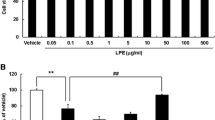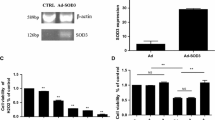Abstract
Diphenyl diselenide (PhSe)2 is a synthetic organoselenium compound displaying glutathione peroxidase-like activity. Protective and antioxidant potential of (PhSe)2 have been extensively investigated in in vivo and in vitro studies. In spite of this, there is a lack of studies addressed to the investigation of potential cytotoxic effect and signaling pathways modulated by this compound. Herein, we aimed to analyze the effects of 24-h treatment with (PhSe)2 on cell viability and a possible modulation of signaling pathways in human neuroblastoma cell line SH-SY5Y. For this purpose, cells were incubated with (PhSe)2 (0.3–30 μM) for 24 h and cell viability, apoptotic cell death and modulation of MAPKs (ERK1/2 and p38MAPK), and PKC substrates phosphorylation was determined. (PhSe)2 treatment significantly decreased cell viability and increased the number of apoptotic cells with induction of PARP cleavage. An increase in ERK1/2 phosphorylation was observed at (PhSe)2 3 μM. In contrast, higher concentrations of the chalcogenide inhibited ERK1/2, p38MAPK and PKC substrate phosphorylation. Pre-treatment with ERK1/2 inhibitor, U0126, increased cell susceptibility to (PhSe)2. Together, these data indicate a cytotoxic potential of (PhSe)2 in a neuronal cell line, which appears to be mediated by the ERK1/2 pathway.




Similar content being viewed by others
References
Barbosa NB, Rocha JB, Wondracek DC, Perottoni J, Zeni G, Nogueira CW (2006) Diphenyl diselenide reduces temporarily hyperglycemia: possible relationship with oxidative stress. Chem Biol Interact 163:230–238
Bobrovskaya L, Gilligan C, Bolster EK, Flaherty JJ, Dickson PW, Dunkley PR (2007) Sustained phosphorylation of tyrosine hydroxylase at serine 40: a novel mechanism for maintenance of catecholamine synthesis. J Neurochem 100:479–489
Borges LP, Nogueira CW, Panatieri RB, Rocha JB, Zeni G (2006) Acute liver damage induced by 2-nitropropane in rats: effect of diphenyl diselenide on antioxidant defenses. Chem Biol Interact 160:99–107
Chang L, Karin M (2001) Mammalian MAP kinase signalling cascades. Nature 410:37–40
Cotgreave IA, Duddy SK, Kass GE, Thompson D, Moldeus P (1989) Studies on the anti-inflammatory activity of ebselen. Ebselen interferes with granulocyte oxidative burst by dual inhibition of NADPH oxidase and protein kinase C? Biochem Pharmacol 38:649–656
Davis RJ (2000) Signal transduction by the JNK group of MAP kinases. Cell 103:239–252
Dong Z, Bode AM (2003) Dialogue between ERKs and JNKs: friendly or antagonistic? Mol Interv 3:306–308
Ghisleni G, Porciúncula LO, Cimarosti H, Rocha JBT, Salbego CG, Souza DO (2003) Diphenyl diselenide protects rat hippocampal slices submitted to oxygen-glucose deprivation and diminishes inducible nitric oxide synthase immunocontent. Brain Res 986:196–199
Ghisleni G, Porciúncula LO, Mioranzza S, Boeck CR, Rocha JBT, Souza DO (2008) Selenium compounds counteract the stimulation of ecto-nucleotidase activities in rat cultured cerebellar granule cells: putative correlation with neuroprotective effects. Brain Res 1221:134–140
Gopalakrishna R, Jaken S (2000) Protein kinase C signaling and oxidative stress. Free Radic Biol Med 28:1349–1361
Gopalakrishna R, Gundimeda U, Chen ZH (1997) Cancer-preventiveselenocompounds induce a specific redox modification of cysteine-rich regions in Ca(2+)-dependent isoenzymes of protein kinase C. Arch Biochem Biophys 348:25–36
Johnson GL, Lapadat R (2002) Mitogen-activated protein kinase pathways mediated by ERK, JNK, and p38 protein kinases. Science 298:1911–1912
Kumar P, Coltas IK, Kumar B, Chepeha DB, Bradford CR, Polverini PJ (2007) Bcl-2 protects endothelial cells against gamma-radiation via a Raf-MEK-ERK-survivin signaling pathway that is independent of cytochrome c release. Cancer Res 67:1193–1202
Luchese C, Stangherlin EC, Ardais AP, Nogueira CW, Santos FW (2007) Diphenyl diselenide prevents oxidative damage induced by cigarette smoke exposure in lung of rat pups. Toxicology 230:189–196
Martin P, Pognonec P (2010) ERK and cell death: cadmium toxicity, sustained ERK activation and cell death. FEBS J 277:39–46
McCubrey JA, Steelman LS, Chappell WH, Abrams SL, Wong EW, Chang F, Lehmann B, Terrian DM, Milella M, Tafuri A, Stivala F, Libra M, Basecke J, Evangelisti C, Martelli AM, Franklin RA (2007) Roles of the Raf/MEK/ERK pathway in cell growth, malignant transformation and drug resistance. Biochim Biophys Acta 1773:1263–1284
Mosmann T (1983) Rapid colorimetric assay for cellular growth and survival: application to proliferation and cytotoxicity assays. J Immunol Methods 65:55–63
Mukherjee S, Bhattacharya RK, Roy M (2009) Targeting protein kinase C (PKC) and telomerase by phenethyl isothiocyanate (PEITC) sensitizes PC-3 cells towards chemotherapeutic drug-induced apoptosis. J Environ Pathol Toxicol Oncol 28:269–282
Nebreda AR, Porras A (2000) p38 MAP kinases: beyond the stress response. Trends Biochem Sci 25:257–260
Nicoletti I, Migliorati G, Pagliacci MC, Grignani F, Riccardi C (1991) A rapid and simple method for measuring thymocyte apoptosis by propidium iodide staining and flow cytometry. J Immunol Methods 139:271–279
Nogueira CW, Zeni G, Rocha JB (2004) Organoselenium and organotellurium compounds: toxicology and pharmacology. Chem Rev 104:6255–6285
Paulmier C (1986) Selenoorganic functional groups. Oxford, England, 25–51
Posser T, Moretto MB, Dafre AL, Farina M, da Rocha JB, Nogueira CW, Zeni G, Ferreira JS, Leal RB, Franco JL (2006) Antioxidant effect of diphenyl diselenide against sodium nitroprusside (SNP) induced lipid peroxidation in human platelets and erythrocyte membranes: an in vitro evaluation. Chem Biol Interact 164:126–135
Posser T, Franco JL, dos Santos DA, Rigon AP, Farina M, Dafre AL, Teixeira Rocha JB, Leal RB (2008) Diphenyl diselenide confers neuroprotection against hydrogen peroxide toxicity in hippocampal slices. Brain Res 1199:138–147
Posser T, Franco JL, Bobrovskaya L, Leal RB, Dickson PW, Dunkley PR (2009) Manganese induces sustained Ser40 phosphorylation and activation of tyrosine hydroxylase in PC12 cells. J Neurochem 110:848–856
Sarker KP, Biswas KK, Rosales JL, Yamaji K, Hashiguchi T, Lee KY, Maruyama I (2003) Ebselen inhibits NO-induced apoptosis of differentiated PC12 cells via inhibition of ASK1–p38 MAPK-p53 and JNK signaling and activation of p44/42 MAPK and Bcl-2. J Neurochem 87:1345–1353
Shavali S, Sens DA (2008) Synergistic neurotoxic effects of arsenic and dopamine in human dopaminergic neuroblastoma SH-SY5Y cells. Toxicol Sci 102:254–261
Takahashi T, Maruyama W, Deng Y, Dostert P, Nakahara D, Niwa T, Ohta S, Naoi M (1997) Cytotoxicity of endogenous isoquinolines to human dopaminergic neuroblastoma SH-SY5Y cells. J Neural Transm 104:59–66
Tamasi V, Jeffries JM, Arteel GE, Falkner KC (2004) Ebselen augments its peroxidase activity by inducing nrf-2-dependent transcription. Arch Biochem Biophys 431:161–168
Tibbles LA, Woodgett JR (1999) The stress-activated protein kinase pathways. Cell Mol Life Sci 55:1230–1254
Wang Z, Jiang C, Ganther H, Lu J (2001) Antimitogenic and proapoptotic activities of methylseleninic acid in vascular endothelial cells and associated effects on PI3 K-AKT, ERK, JNK and p38 MAPK signaling. Cancer Res 61:7171–7178
Acknowledgments
This work was supported by grant from Conselho Nacional de Desenvolvimento Científico e Tecnológico (CNPq). MTP, TP (n°151010/2009-9) and JLF (nº150514/2009-3) were recipients of CNPq fellowship. The authors thank Professor Peter R. Dunkley and Professor Phillip W. Dickson for critical review of the manuscript.
Conflict of interest
The authors declare that they have no conflict of interest.
Author information
Authors and Affiliations
Corresponding author
Rights and permissions
About this article
Cite this article
Posser, T., de Paula, M.T., Franco, J.L. et al. Diphenyl diselenide induces apoptotic cell death and modulates ERK1/2 phosphorylation in human neuroblastoma SH-SY5Y cells. Arch Toxicol 85, 645–651 (2011). https://doi.org/10.1007/s00204-010-0602-0
Received:
Accepted:
Published:
Issue Date:
DOI: https://doi.org/10.1007/s00204-010-0602-0




